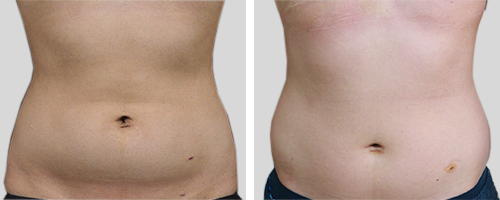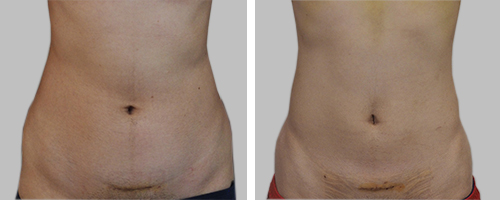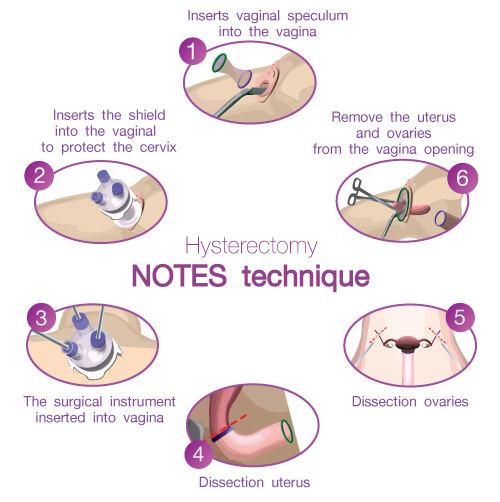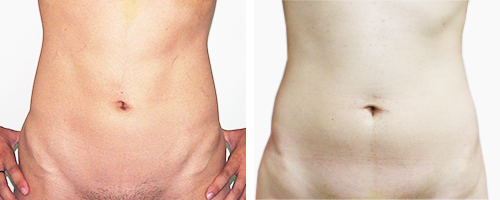FTM Hysterectomy / Bilateral Salpingo-oophorectomy (BSO) in Bangkok, Thailand
Hysterectomy with and without salpingectomy/oophorectomy is considered by WPATH to be a necessary component of gender affirming surgical therapy for transmen who choose to seek this procedure. Hysterectomy has been successfully combined with other gender affirming surgeries performed in the same operating suite including vaginectomy, mastectomy, and genital reconstruction such as metoidioplasty or phalloplasty. Kamol Hospital provides FTM hysterectomy 4 techniques as follows below;
1. Laparoscopic technique:
Instead of making a large incision, the new only makes a few tiny incisions through which thin instruments pass through the abdomen. This new technique significantly reduces scaring, pain, healing time, blood loss, and duration of hospital stay when compared to the open procedure.

Picture 1 shows the scar of the laparoscopic hysterectomy technique.
2. Abdominal Hysterectomy with Bilateral Salpingo-oophorectomy (BSO) or Open Technique
A transverse incision is an abdominal wall, usually above the pubic bone, as close to the upper hairline of the individual's lower pelvis as possible, similar to the incision made for a cesarean section approximately 4-5cm long. This technique allows the surgeon the most exceptional access to the reproductive structures and performs for removal of the entire reproductive complex. Abdominal hysterectomy is the most common method. The recovery time for an open hysterectomy is 4–6 weeks.

Picture 2 shows the scar of an abdominal hysterectomy or open technique.
3. Subsequently the Vaginal or V technique:
Vaginal hysterectomy is performed entirely through the vaginal canal and has clear advantages over abdominal surgery such as fewer complications, shorter hospital stays, and quicker healing time. If this technique is complicated, surgical exploration will be required.
4. Natural Orifice Transluminal Endoscopic Surgery Hysterectomy with Bilateral Salpingo-oophorectomy (BSO) & Oophorectomy or NOTE technique
A new technique removes the uterus and ovaries. Developed from total laparoscopic hysterectomy and transvaginal hysterectomy procedures, which provide more safety. The surgeon inserts a vaginal speculum into the vagina and inserts the shield into the vagina to protect the cervix. Then the surgical instrument is inserted into the vagina. After dissection, both uterus and ovaries are removed from the vagina opening.

Picture 3 shows the process of NOTES technique Hysterectomy
Advantage of NOTES technique Hysterectomy
- No scar
- Less postoperative pain
- Shorter hospital stay and quick recovery of bowel function
- Shorter recovery and faster return to daily activities
- Less complication from bleeding during surgery or less chance of injury in the abdomen
Preparation for Hysterectomy Surgery
-
Gather information. Learn as much as you can about having a hysterectomy. Make sure you understand how the procedure will go, as well as what is involved in the recovery process.
-
Lose weight, if you’re overweight. Being overweight can increase the risks associated with surgery and anesthesia, and severe obesity can increase surgery time and blood loss. If you’re overweight, talk to your doctor about the best way to go about losing weight before your surgery.
-
Stop smoking. Stopping or cutting down on smoking as much as possible can help with general anesthesia and recovery from surgery, Smokers may have problems breathing during surgery, and they tend to heal more slowly afterward.
-
Discuss your medication with your doctor. Talk to your doctor about whether you need to change your usual medication routine before having a hysterectomy. You should also let your doctor know about any over-the-counter medications, such as aspirin, or dietary supplements you’re taking. Some supplements can help prepare you for a hysterectomy. For example, taking a daily multivitamin can help improve general health, and vitamin C can help promote healing. Talk to your doctor about recommended supplements you might take before your hysterectomy surgery.
-
Make sure other medical conditions are well-controlled. If you have diabetes, high blood pressure, sleep apnea, or other medical conditions, check with your doctor to make sure they’re under control before you have a hysterectomy. When other pre-existing conditions are managed,
-
Eat light. Limiting heavy foods and avoiding big meals can help you feel better before and after the procedure. “Eating healthy is always important, but even more so when you plan to have surgery.
Postoperative Care for Hysterectomy
Recovery
Risks and complications:
Before and After Hysterectomy with BSO

Picture 3. Shows the scarless of a NOTES technique




